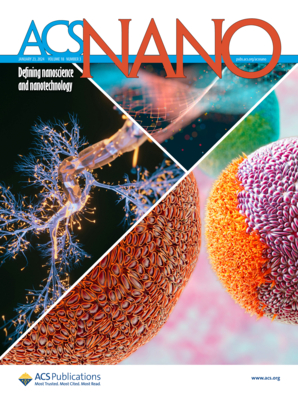Bioinspired, All-In-One, and Robust Dynamic Passive Cooler Enabled by Solvent-Induced Self-Assembly for Temperature-Adaptive Thermal Regulation.
IF 16
1区 材料科学
Q1 CHEMISTRY, MULTIDISCIPLINARY
引用次数: 0
Abstract
Developing passive coolers is a promising thermal management strategy for mitigating severe heat stress and environmental pollution. However, conventional radiative coolers, comprising multilayered and randomly porous structures, face challenges such as specific heat accumulation and compromised mechanical properties. Inspired by the distinctive photonic structure of butterfly wings, we engineered an all-in-one, temperature-adaptive, robust dynamic passive cooler featuring a hierarchically porous network, using a solvent-induced self-assembly strategy to seamlessly graft thermal management materials onto the long nanocellulose molecular chains within an engineered wood template via covalent interactions. The bioinspired dynamic passive cooler (Bio-D cooler) adjusts its performance regarding the ambient temperature via a reversible phase transition. Furthermore, when faced with a high-density heat shock, the Bio-D cooler demonstrates an average temperature drop of 5 °C than conventional radiative coolers, reaching a high cooling power of 130.1 W/m2. Moreover, the Bio-D cooler demonstrates a mechanical strength of 42.9 MPa, nearly ten times higher than conventional dynamic passive coolers. The all-in-one, robust Bio-D cooler demonstrates significant potential for temperature-adaptive thermal regulation applications.生物启发,一体化,和强大的动态被动冷却器由溶剂诱导的自组装温度自适应热调节。
开发被动式冷却器是一种很有前途的热管理策略,可以减轻严重的热应力和环境污染。然而,传统的辐射冷却器由多层和随机多孔结构组成,面临着比热积累和机械性能受损等挑战。受蝴蝶翅膀独特的光子结构的启发,我们设计了一种一体化、温度自适应、强大的动态被动冷却器,具有分层多孔网络,使用溶剂诱导的自组装策略,通过共价相互作用将热管理材料无缝地接枝到工程木材模板内的长纳米纤维分子链上。生物动力被动冷却器(Bio-D冷却器)通过可逆相变调节其环境温度的性能。此外,当面对高密度热冲击时,Bio-D制冷机的平均温度比传统辐射制冷机低5°C,达到130.1 W/m2的高冷却功率。此外,Bio-D冷却器的机械强度为42.9 MPa,比传统的动态被动冷却器高出近10倍。一体化,坚固的Bio-D冷却器显示了温度自适应热调节应用的巨大潜力。
本文章由计算机程序翻译,如有差异,请以英文原文为准。
求助全文
约1分钟内获得全文
求助全文
来源期刊

ACS Nano
工程技术-材料科学:综合
CiteScore
26.00
自引率
4.10%
发文量
1627
审稿时长
1.7 months
期刊介绍:
ACS Nano, published monthly, serves as an international forum for comprehensive articles on nanoscience and nanotechnology research at the intersections of chemistry, biology, materials science, physics, and engineering. The journal fosters communication among scientists in these communities, facilitating collaboration, new research opportunities, and advancements through discoveries. ACS Nano covers synthesis, assembly, characterization, theory, and simulation of nanostructures, nanobiotechnology, nanofabrication, methods and tools for nanoscience and nanotechnology, and self- and directed-assembly. Alongside original research articles, it offers thorough reviews, perspectives on cutting-edge research, and discussions envisioning the future of nanoscience and nanotechnology.
 求助内容:
求助内容: 应助结果提醒方式:
应助结果提醒方式:


